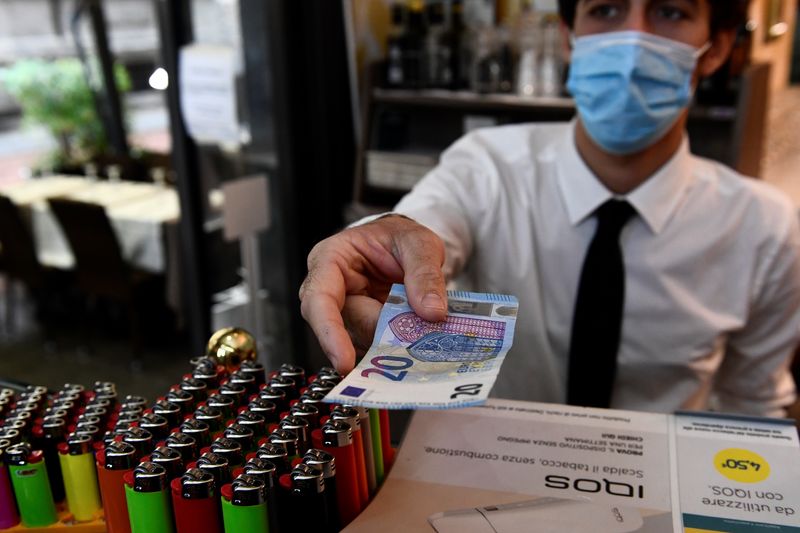
© Reuters. A man uses cash to pay for items while shopping in Milan, Italy, October 2, 2020. REUTERS/Flavio Lo Scalzo
2/2
By Valentina Za, Giuseppe Fonte and Gavin Jones
ROME/MILAN (Reuters) – Italy’s hopes of transforming its economy with billions of euros of European Union pandemic recovery funds are unravelling fast, businesses on the ground say, with inefficiencies at all levels raising the risk of a greater boost to debt than to growth.
In mid-2020 Rome secured the lion’s share of a 724-billion-euro kitty aimed at helping EU members emerge from COVID greener and more tech-friendly.
Italy’s 191.5 billion euros ($210 billion) of cheap loans and grants, to be received in tranches through 2026, was intended for productive investments in the bloc’s most chronically stagnant economy.
Fast-forward three years and Brussels is withholding the funds due to Rome’s failure to keep its part of the bargain: progressively adopting 527 extremely detailed policy “targets and milestones”.
Disputes have arisen over, among other things, a reform of Italy’s port concessions, whether soccer stadium improvements could feature in the plan, and a failure to provide 7,500 extra beds for university students.
Italy is also behind schedule in spending money already transferred, worrying economists and rating agencies eyeing the sustainability of the world’s third-largest debt pile.
Roberto Perotti, economics professor at Milan’s Bocconi University, said Italy had put together its Post-COVID Recovery and Resilience Plan (PNRR) too hastily and requested too much money.
“It was doomed from the start,” he said. “We were unable to decide on sensible projects and we are unable to spend the money on the ones that have been agreed.”
Prime Minister Giorgia Meloni, who took office nine months ago, plans to present a revamped and revised PNRR to Brussels next month.
Blaming the setbacks on her predecessors Mario Draghi and Giuseppe Conte, she told parliament last week: “We will make good use of that money whatever it takes.”
DWINDLING GROWTH IMPACT
Italy has so far received 67 billion euros, with the latest tranche arriving in late 2022. By end-February it had invested 26 billion, about half the amount planned.
As a result, the expected impact on economic growth is diminishing.
The PNRR contributed only 0.1 percentage points to Italy’s buoyant 3.7% growth rate in 2022, according to the Treasury, far less than the targeted 0.7 points.
Even so, in April the government said it would account for 80% of this year’s growth, projected at a meagre 1%, underscoring the importance of resuscitating the project.
Italy was the only country to accept not only EU grants but also all the loans it was entitled to, worth almost two-thirds of the total, betting that a boost to growth would offset the impact on debt. Investors now worry the gamble could backfire.
“We have to grow by 2% per year,” said Carlo Messina, the chief of Intesa Sanpaolo (OTC:), Italy’s largest bank and its second biggest creditor after the European Central Bank.
“It’s only with investments that we can accelerate growth.”
Vittorio Soldavini, the head of H.T. High Technology, a northern Italian software company, said the PNRR’s problems had put businesses’ investment plans on ice.
“Our clients include public bodies that are waiting for the money but they don’t know if they are going to get it … public investments can’t begin, and that also applies to private companies.”
Behind the problems lie poor planning and a shortage of qualified personnel to help local councils – who manage a large chunk of the projects – organise tenders and oversee progress.
“We lack lawyers, accountants, engineers, everything,” said Davide Carlucci, who leads Recovery South, a network of 323 mayors in Italy’s under-developed south, where 40% of the PNRR cash is supposed to be spent.
“It’s been a wasted opportunity,” he said.
Gustavo Piga, an economics professor who teaches procurement policy at Rome’s Tor Vergata University, said salvaging the PNRR would require “large-scale hiring of public tender experts on well-paid, permanent contracts”.
MICRO-PROJECTS
More than half the EU money is meant to go on digitalisation and ecological transition, with the rest devoted to sustainable transport, education, social cohesion and health.
Yet amid growing public disenchantment, Italian media have made fun of myriad micro-projects unlikely to help growth, such as cemetery enlargements or the opening of a ham museum in a village near Parma.
For more ambitious schemes, companies are exasperated by lengthy bureaucratic procedures.
A northern engineering firm presented a project a year ago to produce high-tech, light-weight automotive materials. After vetting by a bank and the national research council, it hopes to get approval late this year, allowing work to begin in 2024.
Considering how quickly innovation projects become obsolete, two years is a long time to wait, its chief executive told Reuters, asking not to be named due to the sensitivity of the matter.
The government is still awaiting a 19-billion-euro tranche of the EU funds blocked in March over missed policy targets stemming from 2022.
It also missed an end-June deadline for the next round of targets and milestones, meaning an additional 16-billion-euro tranche due this year may not come before 2024, hurting Rome’s already creaking public finances.
Ilaria Gobbato, a tenders specialist at law firm Dentons, said fresh problems are likely to arise from the adoption this month of a new legal code for public contracts.
It brings Italy’s byzantine rules closer to EU standards, but Gobbato said people will initially find it hard to adapt.
“You have to ask yourself how many administrations will be ready to issue tenders from tomorrow,” she said.
($1 = 0.9121 euros)





